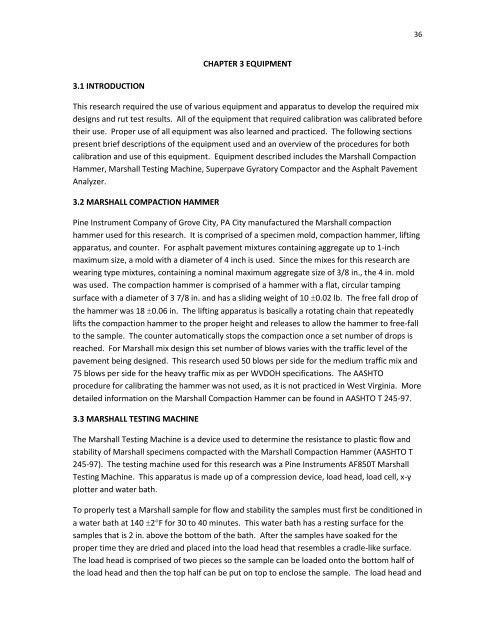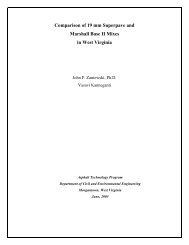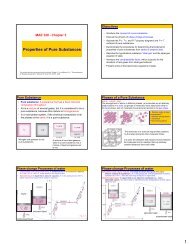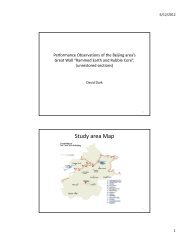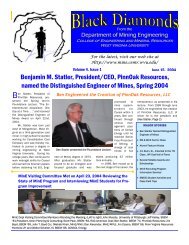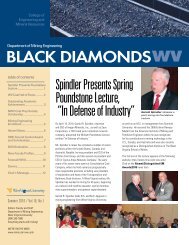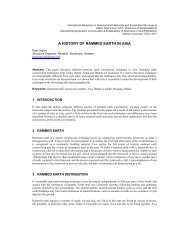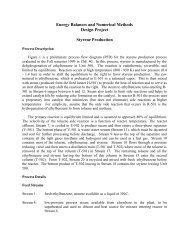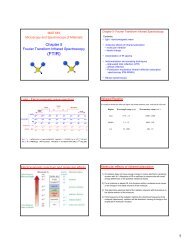Comparison of 9.5 mm SuperPave and Marshall Wearing I Mixes in ...
Comparison of 9.5 mm SuperPave and Marshall Wearing I Mixes in ...
Comparison of 9.5 mm SuperPave and Marshall Wearing I Mixes in ...
You also want an ePaper? Increase the reach of your titles
YUMPU automatically turns print PDFs into web optimized ePapers that Google loves.
36CHAPTER 3 EQUIPMENT3.1 INTRODUCTIONThis research required the use <strong>of</strong> various equipment <strong>and</strong> apparatus to develop the required mixdesigns <strong>and</strong> rut test results. All <strong>of</strong> the equipment that required calibration was calibrated beforetheir use. Proper use <strong>of</strong> all equipment was also learned <strong>and</strong> practiced. The follow<strong>in</strong>g sectionspresent brief descriptions <strong>of</strong> the equipment used <strong>and</strong> an overview <strong>of</strong> the procedures for bothcalibration <strong>and</strong> use <strong>of</strong> this equipment. Equipment described <strong>in</strong>cludes the <strong>Marshall</strong> CompactionHa<strong>mm</strong>er, <strong>Marshall</strong> Test<strong>in</strong>g Mach<strong>in</strong>e, Superpave Gyratory Compactor <strong>and</strong> the Asphalt PavementAnalyzer.3.2 MARSHALL COMPACTION HAMMERP<strong>in</strong>e Instrument Company <strong>of</strong> Grove City, PA City manufactured the <strong>Marshall</strong> compactionha<strong>mm</strong>er used for this research. It is comprised <strong>of</strong> a specimen mold, compaction ha<strong>mm</strong>er, lift<strong>in</strong>gapparatus, <strong>and</strong> counter. For asphalt pavement mixtures conta<strong>in</strong><strong>in</strong>g aggregate up to 1-<strong>in</strong>chmaximum size, a mold with a diameter <strong>of</strong> 4 <strong>in</strong>ch is used. S<strong>in</strong>ce the mixes for this research arewear<strong>in</strong>g type mixtures, conta<strong>in</strong><strong>in</strong>g a nom<strong>in</strong>al maximum aggregate size <strong>of</strong> 3/8 <strong>in</strong>., the 4 <strong>in</strong>. moldwas used. The compaction ha<strong>mm</strong>er is comprised <strong>of</strong> a ha<strong>mm</strong>er with a flat, circular tamp<strong>in</strong>gsurface with a diameter <strong>of</strong> 3 7/8 <strong>in</strong>. <strong>and</strong> has a slid<strong>in</strong>g weight <strong>of</strong> 10 0.02 lb. The free fall drop <strong>of</strong>the ha<strong>mm</strong>er was 18 0.06 <strong>in</strong>. The lift<strong>in</strong>g apparatus is basically a rotat<strong>in</strong>g cha<strong>in</strong> that repeatedlylifts the compaction ha<strong>mm</strong>er to the proper height <strong>and</strong> releases to allow the ha<strong>mm</strong>er to free-fallto the sample. The counter automatically stops the compaction once a set number <strong>of</strong> drops isreached. For <strong>Marshall</strong> mix design this set number <strong>of</strong> blows varies with the traffic level <strong>of</strong> thepavement be<strong>in</strong>g designed. This research used 50 blows per side for the medium traffic mix <strong>and</strong>75 blows per side for the heavy traffic mix as per WVDOH specifications. The AASHTOprocedure for calibrat<strong>in</strong>g the ha<strong>mm</strong>er was not used, as it is not practiced <strong>in</strong> West Virg<strong>in</strong>ia. Moredetailed <strong>in</strong>formation on the <strong>Marshall</strong> Compaction Ha<strong>mm</strong>er can be found <strong>in</strong> AASHTO T 245-97.3.3 MARSHALL TESTING MACHINEThe <strong>Marshall</strong> Test<strong>in</strong>g Mach<strong>in</strong>e is a device used to determ<strong>in</strong>e the resistance to plastic flow <strong>and</strong>stability <strong>of</strong> <strong>Marshall</strong> specimens compacted with the <strong>Marshall</strong> Compaction Ha<strong>mm</strong>er (AASHTO T245-97). The test<strong>in</strong>g mach<strong>in</strong>e used for this research was a P<strong>in</strong>e Instruments AF850T <strong>Marshall</strong>Test<strong>in</strong>g Mach<strong>in</strong>e. This apparatus is made up <strong>of</strong> a compression device, load head, load cell, x-yplotter <strong>and</strong> water bath.To properly test a <strong>Marshall</strong> sample for flow <strong>and</strong> stability the samples must first be conditioned <strong>in</strong>a water bath at 140 2 F for 30 to 40 m<strong>in</strong>utes. This water bath has a rest<strong>in</strong>g surface for thesamples that is 2 <strong>in</strong>. above the bottom <strong>of</strong> the bath. After the samples have soaked for theproper time they are dried <strong>and</strong> placed <strong>in</strong>to the load head that resembles a cradle-like surface.The load head is comprised <strong>of</strong> two pieces so the sample can be loaded onto the bottom half <strong>of</strong>the load head <strong>and</strong> then the top half can be put on top to enclose the sample. The load head <strong>and</strong>


